Retail Holiday Newsletter
Omnichannel GAFO 1 sales grew 4.4% over the holiday season (November and December), in line with expectations. E-commerce sales increased 15%, more than five times the in-store growth rate of 2.9%. Looking forward, traditional retailers will continue to face long-term challenges as lower-volume stores become unprofitable on a stand-alone basis. Breakthrough innovations will be needed to transform customer experiences and to modernize store networks. In this season’s final newsletter, we recap holiday sales results and discuss four keys to success in driving breakthrough innovations.
The season in review
Preliminary estimates indicate that holiday omnichannel GAFO sales grew 4.4% over last year (see Figure 1). Robust online sales and pervasive promotions boosted top-line performance, as did weather and delivery logistics, both much improved over last year. Upcoming fourth-quarter earnings announcements will shed light on how discounts, free-shipping offers and unsold inventory impacted retailers’ profit margins.
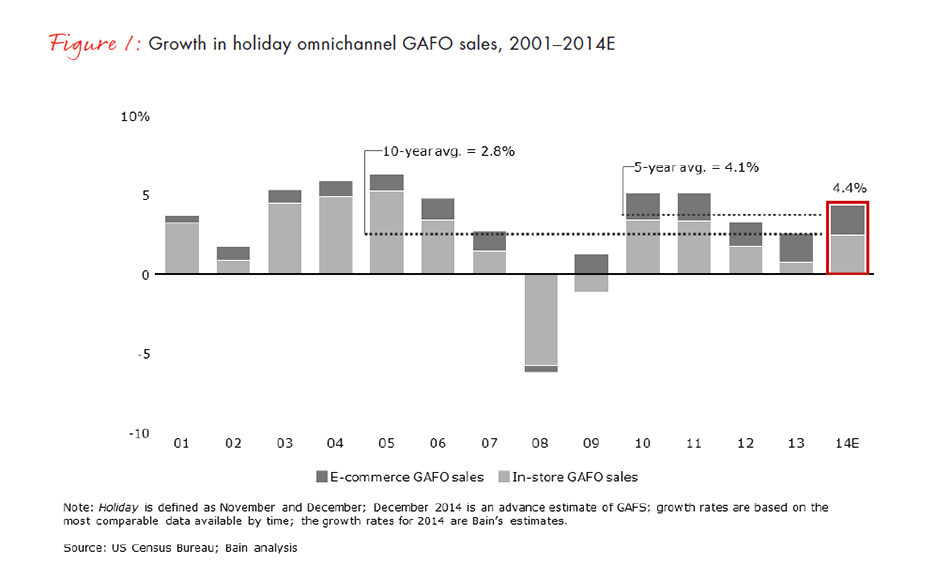
Initial GAFO sales results suggest in-store sales grew by 2.9% this season. Although that’s higher than last year’s growth of just 1%, it’s lower than growth in 26 of the last 35 years (see Figure 2), suggesting a modest performance despite the healthier economy. Electronics stores and sporting goods, hobby, book and music stores experienced the strongest growth—5.7% and 5.0%, respectively. Non-GAFO sales grew 4.8% this holiday season, spurred by an 8.5% increase in sales of automobiles.
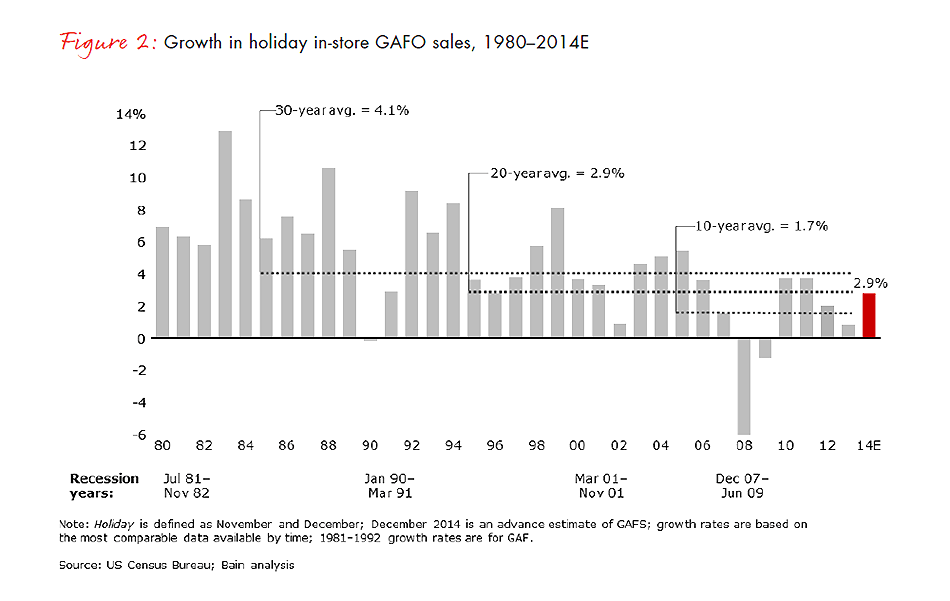
Online sales significantly outpaced growth in in-store GAFO sales, and they continue to gain meaningful share from stores. Growth in online holiday sales reached 15% (see Figure 3), with mobile sales growing 27%. Although e-commerce sales accounted for less than 15% of total GAFO sales this holiday season, they contributed to more than 40% of the growth in total omnichannel GAFO sales.
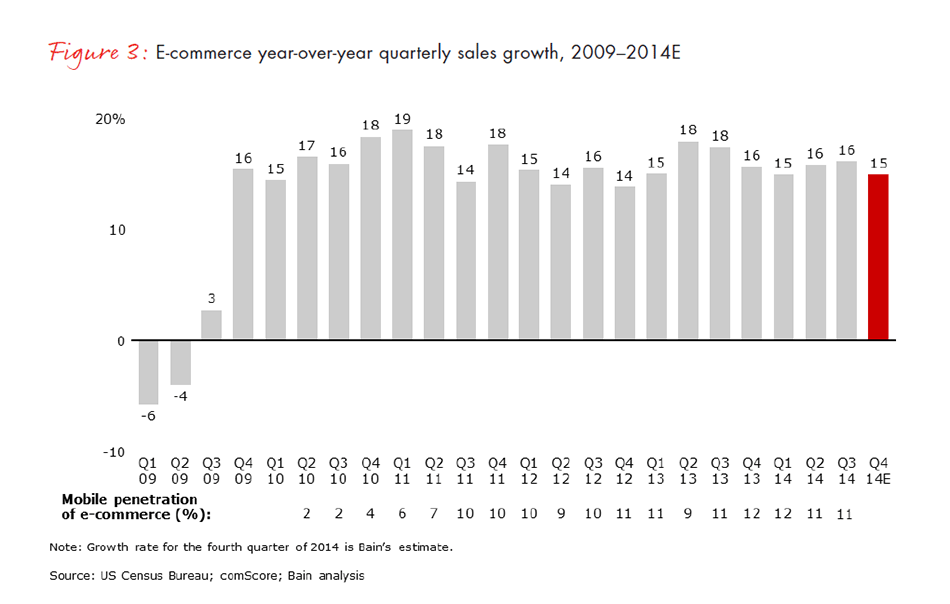
The innovation imperative
Although holiday sales met analysts’ growth expectations, they didn’t resolve retailers’ most fundamental quandary: what to do about the rising number of stores operating at or below breakeven. The most common response is to further reduce expenses in stores and continuously close the bottom tier. The problem with this is that stores become even less appealing while store networks lose their scale advantage. Closing stores that have lost, say, 15% of their sales not only forfeits the remaining 85% of sales from those stores; it also puts 10% to 30% of the online sales coming from the stores’ catchment areas at risk because online shoppers can no longer test products, pick them up or return them in local stores. Then there’s diminished scale, which forces cuts in merchandising and marketing investments, erodes vendor support and often drives dangerous diversification investments to fill growth gaps. Ironically, all of this seems to be happening while online retailers grow increasingly excited about opening physical stores.
There is another way. It involves not only incremental improvements to store networks and supply chains, but also breakthrough innovations that change the rules of the game. Bain’s research shows that top-quartile innovators grow almost three times as fast as average companies (see Figure 4). They are also winning the war for talent, achieving a remarkable 79-point advantage in employees’ willingness to recommend the company as a great place to work. These findings may well explain why more retailers and mall developers are now opening innovation labs.
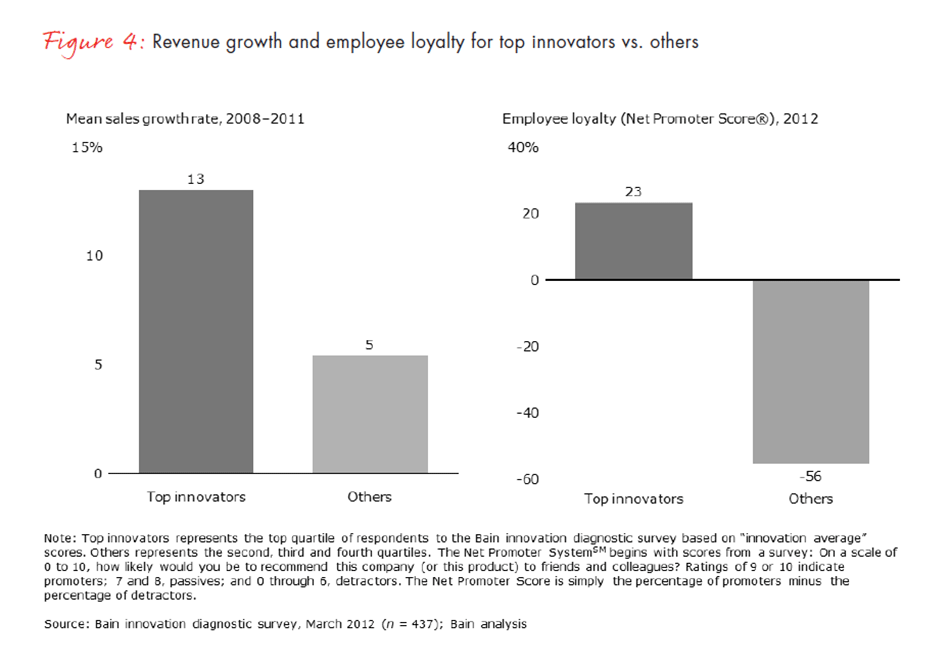
Breakthrough innovation is unfamiliar territory for most retail organizations; in fact, it’s dicey even for the most experienced innovators. Google’s withdrawal of Google Glass from the consumer market and Amazon’s failed Fire Phone are only two recent examples of the pitfalls world-class innovators can encounter. To understand the drivers of successful breakthroughs, Bain analyzed innovation leaders in more than 20 industries, studied the successes and failures of retail innovation labs, and interviewed executives who are leading successful innovation efforts.
We found four consistent keys to success:
- Create visions, not pipedreams. Just because something can be done doesn’t mean it should be. Consider, for example, the “Belty,” a motorized “smart belt” that expands or contracts when the wearer sits or stands. Innovations like this one are pipedreams—gadgets that are unlikely to ever generate substantial profits. An effective innovation, on the other hand, starts with a vision that is sufficiently bold and transformative to succeed yet is focused on solving an actual problem. Integral to that vision is an understanding of the IT skills, resources and strategies it will take to turn ambition to commercial reality. An effective innovation is compelling enough to inspire extraordinary commitment and credible enough to warrant the effort. Innovation is defined as the profitable application of creativity and is found in just one place: the intersection of important customer opportunities, distinct capabilities and competitor vulnerabilities.
- Assemble the capabilities to win. Executives tend to assume that the resources needed for “moonshots” can’t be anticipated, that they simply need to set bold goals, jump in and hope hard. That thinking is both wrong and reckless. Before President John Kennedy committed to putting a man on the moon, Vice President Lyndon Johnson worked with the country’s leading experts, including people from NASA and the Department of Defense, to determine whether it was possible, what financial and technological resources would be necessary and how long it would take. Although Kennedy wanted fast and cheap, NASA’s boss insisted on setting a 10-year time frame and a $20 billion budget. The lunar landing was delivered on time and about 25% over budget—not bad compared to most corporate innovation projects. Innovators must be sure they have the human, financial, physical, technological and knowledge resources they need to succeed, and the time to do so.
- Master experimental design. Breakthrough innovations do things that have never been done before. By definition, they operate in uncertainty. Experts estimate that more than three-quarters of new ventures fail and that two-thirds of those that succeed do so only with significant modifications to their original plans. Innovation leaders know what questions to ask and design tests to answer those questions. They challenge conventional wisdom and test whether consumers will actually behave as they claim they will. They design intelligent experiments, testing and retesting; but they also know when to quit. This is true even for the most seasoned innovators. Two cases in point: Amazon recently backed out of its mobile wallet app in the wake of weak beta-testing results; and the online retailer stopped selling its premium private-label diapers in light of negative customer feedback.
- Commercialize for success. Building a workable prototype is one thing; scaling it to commercial success is another. Key to commercialization is early planning: anticipating roadblocks, setting milestones, establishing feedback loops and adjusting to real-world economics and conditions. Also critical is actively engaging the front line, making sure that proposed changes are understood and embraced by the people they affect. Leading innovators broaden communications from a need-to-know basis to a might-need-to-know mindset to prepare the organization for smooth implementation.
Breakthrough innovators: Disney and Hointer
To bring these lessons to life, let’s examine two examples of recent breakthrough innovations: Disney’s Next Generation Experience, aimed at transforming the visitor experience, and Hointer, a start-up focused on revolutionizing apparel shopping. These examples have many similarities but also notable differences that make them interesting to study and relevant to a variety of situations.
Disney is a thriving $50 billion company that set out to transform its already legendary visitor experience. The company formed a separate entrepreneurial unit dedicated to developing Disney’s Next Generation Experience. Over more than four years, the team re-envisioned and revolutionized all aspects of Disney’s parks and resorts experience—from booking to arrival, attractions, departures and after-trip memories. It created MyMagic+, an integrated technology linking ride, restaurant and hotel reservation systems; FastPass+, which lets guests reserve attraction times and seats for shows; and MagicBands, RFID wristbands that interact with sensors in the park to transmit behavioral information, allowing guests to receive tailored messages on everything from wait times for rides to weather, and to engage with cast members in personalized ways to make their experience even more "magical."
Hointer, on the other hand, is a start-up conceived to overcome the frustrations of buying clothing online. Nadia Shouraboura, its founder, had been a successful executive at Amazon for 10 years, helping the e commerce juggernaut conquer category after category, from books to consumer electronics, to power tools. But clothing was different. Progress was slow. Customers were having trouble finding the right fit, so returns were higher and customer satisfaction was lower. Shouraboura knew there had to be a better way. The original concept evolved over time to become an end-to-end solution for retail stores—digitized product information, smart fitting rooms and streamlined backroom operations, enabling customers to browse easily and try on a larger selection of clothes. It also allowed sales associates to use customer and product data to make personalized recommendations. The result: improved customer experiences, higher sales and fewer returns.
1. Create visions, not pipedreams.
Disney’s vision for the Next Generation Experience was to take every element of the vacation experience to a new level. By incorporating new technologies into theme parks, it would create a superior visit and eliminate common pain points for Disney’s guests. “Within the Disney parks and resorts, we deal in the physical environment. We are increasingly finding ways to enhance . . . the experience people have [to make] that environment more immersive,” said Tom Staggs, chairman of Walt Disney Parks and Resorts, at The Wall Street Journal’s D11 conference in 2013.
Disney’s vision required more than incremental change. It reimagined the entire theme park experience, affecting nearly every customer touch point from well before visitors arrive to long after they leave. Real-time data on guest behaviors, information on past experiences, and contextual data such as weather could allow entertainers to wish visitors “happy birthday” by name and restaurants to send out personalized real-time offers, while real-time ride suggestions could help guests spend less time waiting in line. Meanwhile, Disney could use data on traffic patterns and spending habits to redirect foot traffic, create labor efficiencies and optimize the company’s future investments.
Once Disney had a clear vision, it translated it into inspiring objectives and memorable mantras. “The thing that [Disney] did very intelligently is to start out with a really clear business objective,” said Ric Merrifield, business lead for product development at Synapse, who collaborated with Disney. The objectives focused on customer and business priorities, setting a clear path for the development of innovation. Disney distilled its aspirations into a simple message, articulated by Staggs in his Disney Parks Blog, as creating “a more immersive, more seamless and more personal experience.” This simple message made it easy for Disney to communicate its key objectives both internally and externally, and to create a rallying cry that mobilized the entire organization.
Like Disney, Hointer wanted to create a holistic system that would dramatically improve nearly every element of the customer experience. Shouraboura believed that the touch and feel aspects of physical stores are essential to the apparel shopping experience. Although the original store concept utilized little technology, Shouraboura quickly recognized the opportunity to merge the best of her technology background with the best of physical stores.
Hointer’s vision evolved to transform the shopper and sales associate experience from beginning to end by using technology to simplify, streamline and declutter both the front and back of the store. Shouraboura wanted to create a store environment where shoppers could enjoy the collection instead of fumbling through piles of clothes, and where sales associates could spend less time folding and restocking, and more time focusing on customers. In developing its new concept, Hointer tried to replicate two key advantages from the online world: endless amounts of product information and the information necessary to tailor recommendations to individual customers. While moving through the store, customers and sales associates could access additional product information through digitized displays. Digitally enhanced fitting rooms made it easier for customers and sales associates to select and send through the right sizes and styles to try on, eliminating the hassle of carrying items around the store. Sales associates could access Hointer’s online Look Books, provide pairing recommendations and send for additional items, all while staying by the customer’s side throughout his or her shopping journey.
Just as Disney’s improvement in the customer experience would help optimize its business operations, Hointer’s vision included streamlined store operations and back-of-store processes. Most inventory was removed from the sales floor and placed in backroom micro warehouses. These were connected to fitting rooms so that items that didn’t work could easily be restocked, while additional recommended items could quickly be retrieved for trial. This meant that customers could try on more products that were better suited to their needs even while store labor was used more efficiently: “[Because] everything is in the back in a micro warehouse, your productivity goes up about 10 times. So I can spend less associate time and let customers try on ten times more,” explains Shouraboura.
2. Assemble the capabilities to win.
Creating a world-class experience for Walt Disney World guests was important enough for Disney to reportedly invest more than $1 billion in the project—roughly equivalent to the cost of two cruise ships or of entirely remodeling one of its theme parks. Disney established the Next Generation Experience as a separate entity, ultimately hiring more than 1,000 employees with a broad range of crucial skills, including IT, engineering, operations and marketing.
Disney has a long history of leveraging technology to enhance the experience of its guests, but NextGen required new competences. In addition to new technologies, the company’s vision also demanded advanced data analytics. To deliver a more personalized theme park experience, Disney needed the ability to create comprehensive and longitudinal views of guests’ behavior across channels, activities and time, and then translate them into data sets for predictive analytics. To do so, Disney not only expanded existing in-house technological resources; it also partnered with external providers to capitalize on the latest technologies and Big Data capabilities.
While Disney’s Next Generation Experience drew on the resources of a large corporation, Hointer operated on a much smaller scale with limited financial resources. Hointer found cost advantages in implementing technologies that made use of customers’ mobile phones, thereby avoiding significant hardware costs. Says Shouraboura: “I needed to be extremely frugal in everything I did. I had to design in a very cost-efficient way. Our ideas had to be able to be rolled out to hundreds of stores.”
Still, Hointer did require significant technological and data capabilities to harness product information and customer data. Digital tagging “instantly [brings customers into] the digital world, connected with information about the product, images about the product.” It allows Hointer to easily track the performance of specific items in terms of what customers tried on, what they purchased and inventory levels. Hointer also created detailed customer profiles to better understand individual customers and offer a more personalized experience: “[Our customer CRM] captures the customers, their visits to the store, what they tried on, what they bought. . . . We know what they like, what they don’t like.” Customized algorithms help sales associates recommend as many as two-thirds of the items customers try on, and customers typically purchase a quarter of these items. Returns are virtually nonexistent.
Although Shouraboura was able to apply her technological expertise from her time at Amazon, the physical world of retail was foreign to her. According to Shouraboura, “While I had strong technology skills, I was very bad at the store design, the merchandising, the presentation of the product in [the] store.” She recognized that “developing the capabilities of physical store retailers myself could be very expensive, take too much time and require too much knowledge.” Instead, she partnered with a handful of leading retailers to leverage their extensive knowledge of brick-and-mortar stores.
3. Master experimental design.
Turning Disney’s vision into reality required a highly flexible development process that made extensive use of testing. According to Merrifield, “We did a lot of tests before we even got into the park. We had some labs and environments where we could make sure the technology worked in a separate self-contained environment. We then . . . did some tests at night and some tests with employees . . . to test things like weather.” The team also ran experiments on the Big Data platform that would enable the customer experience. Starting small, it built the data platform with a limited and flexible team, quickly learning from early failure and improving along the way, eventually shifting from open-sourced to more reliable paid tools that could handle the amount of data Disney processes.
After more than four years of development, Disney launched MyMagic+ with a group of 1,000 users at Walt Disney World Florida before expanding across its other venues. This testing revealed how customers would use the tools provided to them and, accordingly, how Disney could further optimize the customer experience. As Merrifield explains, “There were a lot of things the customers were doing with the bands that weren’t expected and weren’t part of our test cases because that was just not how we thought about it.” Based on these insights, for example, cast members were coached in ways to adapt to customers’ preferences and maximize their happiness. Disney used a similar testing process when rolling the concept out: MagicBands were first made available to hotel guests and then to annual pass holders before being deployed to all park visitors, enabling the company to make any necessary adjustments along the way.
Disney’s method of experimental design has led to a cycle of continuous enhancements of specific elements of the experience. For example, Disney has released multiple versions of its mobile app since launch, and it recently integrated photo-tracking functionality into its MagicBands. The company is in the process of testing other new features for guests as well, among them adding FastPass+ entitlements during their visit and viewing bus arrival times on mobile devices. As Staggs explains in an interview with the Orlando Sentinel, “MyMagic+ was really built to evolve. . . . We’re still looking at ways we can add additional features. . . . That fleshing out will continue for some time, maybe forever.”
On a smaller scale, Hointer continues to innovate on a daily basis, constantly testing ideas and improving them. According to Shouraboura, “We probably do over one hundred experiments a year. We try them out for a week to see if [they work]. . . . The vast majority of our ideas don’t work. We roll them out, and we see that what looked like a really brilliant idea ends up being completely useless. And we see it very quickly.”
Hointer makes sure that any new technology introduced to stores during its experiments actually improves the customer experience and business outcomes. The company considers two metrics to assess the benefit of new technologies: the customer conversion rate, measured by the number of customers who return to the stores after their first purchase, and the item conversion rate, defined as the number of customers who make a purchase after trying on an item. As Shouraboura explains, “When we try any new technology in our store, we always look at customer conversions and item conversions and see what the new technology does to them and make sure [they go] up.” Handling customer feedback was taken so seriously at Hointer that developers were on site in its Seattle store to respond to customers’ requests. The result is a process of continuous improvement like Disney’s, taking in feedback from customers and bringing in new technologies to create a truly unique customer experience.
Over time, this cycle of testing, learning and improving led Hointer to redefine its business model. Shouraboura explains: “I started to think a lot about all of the components that go into a fantastic customer experience. I was very strong in one component but not in others.” Accordingly, Hointer shifted from being a tech-savvy apparel retailer to becoming a technology company that licenses its product to retailers, offering them the opportunity to benefit from its powerful digital and technological capabilities.
4. Commercialize for success.
To make Hointer commercially viable, it needed to be scalable at a reasonable cost. While ”extensive gadgetry” may work for one store as a demo, Shouraboura says, “when you have tens or hundreds of stores, and hundreds of fitting rooms and hundreds of checkout points, it needs to be very cost efficient.” So Shouraboura scaled back certain technologies. Realizing, for example, that a large retailer with thousands of SKUs couldn’t afford to add an RFID tag to every item, she opted to place the tags only on display items. Shouraboura says she had to set realistic economic objectives: “How do I create the same customer experience but without the expensive technology—without RFID, without robotics in the back, without having a computer in every store. Now we have a situation where you get the same experience, but it costs very little and the customer doesn’t even notice.”
Hointer also commercialized economic advantages in its inventory policies. While traditional retailers buy to fill fixtures and stores, Hointer’s technology means stores need just one of each item on the sales floor. This has dramatic benefits: greater assortment, lower inventory levels and fewer markdowns. However, it also requires buyers to adopt new ways of working: “You actually buy a lot differently if you buy for demand than if you buy for display,” Shouraboura says.
For Disney, successful commercialization meant understanding the impact its innovations would have on the organization. “Pretty much every part of our business was involved,” remarked Staggs in an interview with Fast Company. Changing turnstiles required engaging the security team; replacing door locks impacted hotel staff and customer service, and resulted in changes to the reservation system. Engaging those individuals at the front line whose day-to-day operations would change significantly was critical to the successful execution of the overall vision.
Disney also sequenced the rollout assiduously. To ensure a smooth reliable launch, the company deployed changes in stages. Instead of transforming one entire theme park at a time, specific components of the experience were rolled out individually across as many Disney World venues as possible. By starting with changes to door locks and then moving on to turnstiles and geolocation tracking, Disney was able to keep the customer experience consistent across all parks. With the commercialization success in Walt Disney World, Disney has embarked on additional phases of rollout. MagicBands were used on Disney Cruise Line for youth activities as early as 2013, and Staggs recently announced plans to deploy My Magic+ across Disneyland venues.
The actions Disney and Hointer have taken to drive breakthrough innovations are paying off. Within the first year of Disney’s Next Generation Experience, almost 10 million park guests wore MagicBands. If the numbers hold up, the company should earn a healthy return on its investment. Meanwhile, Hointer’s technology is now being adopted by some of the largest retailers in the country, with the potential to expand beyond clothing into other products that benefit from touch and feel experiences.
Looking ahead
We head into 2015 on improved economic footing, but retailers still face challenges. Winners will rethink the role of their stores as brand statements, shipping hubs or centers of differentiated experience, and markedly improve network economics. Like Disney and Hointer, retailers successful at this type of breakthrough innovation will base their visions on real customer and business needs, ensure they have the capabilities to win, master experimental design, and be thoughtful in how they commercialize.
This is the final issue of this season’s holiday newsletters. We hope you've enjoyed our discussions of technology, supply chains, pricing and innovation. To view the full series, please visit www.bain.com/holiday. We look forward to keeping in touch with you over the course of the year and will be back in October with our 2015 holiday outlook. As always, we welcome your questions and perspectives.
Appendix
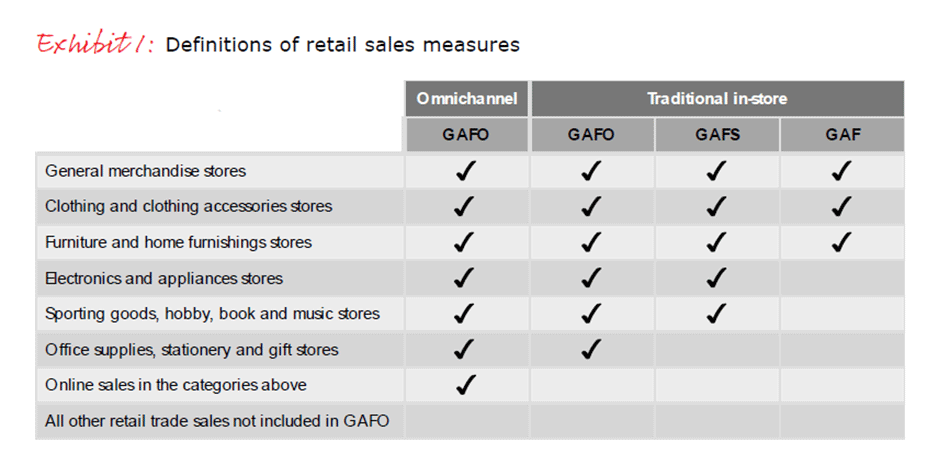
For a list of selected references, please view the full PDF
1 GAFO sales include sales at general merchandise stores; clothing and clothing accessories stores; furniture and home furnishings stores; electronics and appliances stores; sporting goods, hobby, book and music stores; and office supplies, stationery and gift stores. GAFS sales, an advance estimate of GAFO sales, have been used for December sales. See Exhibit 1 above for definitions of GAFO and other sales measures.




